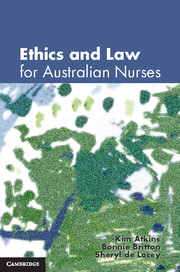Book contents
- Frontmatter
- Contents
- Introduction
- 1 Understanding the human person
- 2 Understanding legal rights and obligations
- 3 Nursing and the legal system
- 4 The nurse–patient relationship
- 5 Consent
- 6 Duty of care and professional negligence
- 7 Patient information, confidentiality and trust
- 8 ‘Trust me, I’m a nurse’
- 9 Witnessing and making mistakes
- Appendix: Tables of legislation
- References
- Index
- References
8 - ‘Trust me, I’m a nurse’
- Frontmatter
- Contents
- Introduction
- 1 Understanding the human person
- 2 Understanding legal rights and obligations
- 3 Nursing and the legal system
- 4 The nurse–patient relationship
- 5 Consent
- 6 Duty of care and professional negligence
- 7 Patient information, confidentiality and trust
- 8 ‘Trust me, I’m a nurse’
- 9 Witnessing and making mistakes
- Appendix: Tables of legislation
- References
- Index
- References
Summary
LEARNING OBJECTIVES
In this chapter, you will:
Develop your understanding of how, through the therapeutic relationship, the nurse can empower the patient to make decisions about treatment that the patient really wants
Gain an understanding of the nature and role of trust in the nurse–patient relationship
Develop your understanding of the scope of a patient's right to negotiate treatment, including alternative therapies
This chapter will further explore the moral and legal aspects of the nurse–patient relationship, with special attention to the role of trust. Lena's situation demonstrates how a patient can be disempowered and rendered increasingly vulnerable through careless use of professional power. Lena's sadness at being parted from her friend (a normal reaction) has been turned into a medical condition (or ‘medicalised’), which is then recorded in her file as if it is a fact about her. Then this purported medical condition is used as a reason to pry into Lena's private life – and all without any consultation with Lena herself. When Lena expresses quite justifiable outrage, she is further cast as a problem patient, and her anger is regarded as part of her emotional instability.
- Type
- Chapter
- Information
- Ethics and Law for Australian Nurses , pp. 174 - 194Publisher: Cambridge University PressPrint publication year: 2011



